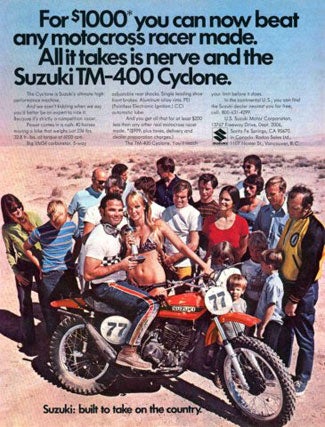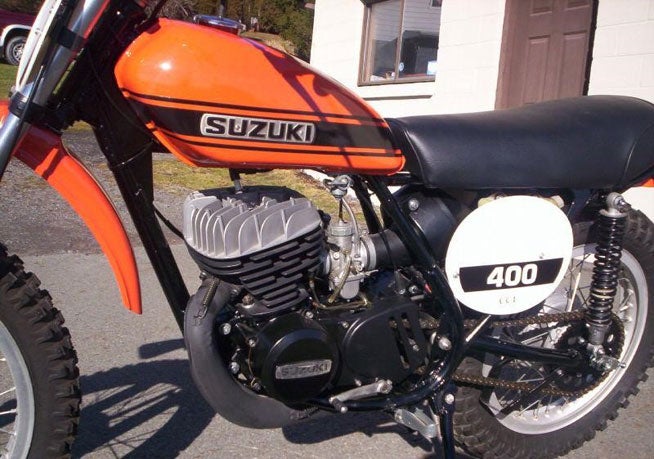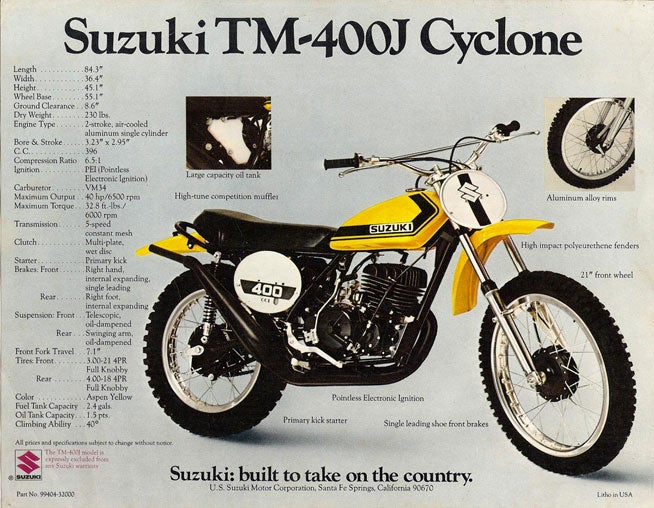Vintage bike guru Matt Cuddy reminds us why the TM in Suzuki’s TM400 Cyclone model designation probably stood for “Throw Me.”

Ahh, spring time, when a man’s fancy turns to love…
Back in the spring of 1973 my riding buddy Rick had finally wore out his CT1 Yamaha, and he was looking for love in the want ads of Cycle News. Rick wanted a big-bore machine that he could feel at home on after all those years of eating dust on his puny 175.
After a few minutes of looking, in the 1971 advertisement section of Cycle News in bold type, we found an ad for a slightly used 1971 Suzuki TM400 Cyclone for the unbelievably low price of $500. We called up the seller, who lived in Sylmar, and quickly boogied on over in Rick’s 1963 F250 Ford pick-up with tie downs in hand. We’d heard stories of how fast and dangerous the Cyclone was, but we poo-poohed these rumors as most likely the ramblings of squids and turkeys that couldn’t handle the raw power of an open-class machine.
When we pulled up to the tidy little house on San Fernando Road in Sylmar, and were greeted at the front door by a big guy with a giant cast on his right leg and bandages on both elbows. He motioned us inside and closed the screen door behind us.
“The bike’s out back” he whispered. Why was he whispering, both Rick and I wondered? Maybe someone was asleep?
So we went out to the back yard, and there it was, an orange and black 1971 Suzuki TM400 Cyclone, sitting in the driveway. It was a very pretty bike, with its black motor, plastic fenders and alloy rims. It didn’t seem to have much wear and tear on it for a two-year-old dirt bike. The knobbies even still had those little rubber whiskers on ‘em. Seemed like it’d only been ridden a couple times, at most.

“Can I start it up?” Rick asked, to which the owner replied “Sure, you can take it down the alley out back too if you want.” The seller seemed agreeable, so Rick started it on the third kick, and carefully made his way to the alley behind the house.
The Cyclone sounded like a real race bike; exhaust crackling from its long black open stinger. Rick clicked it into gear, and went quickly down the alley in a haze of blue CCI smoke. When Rick got back, his eyes were as big as cue balls.
“Jeezus this thing is fast!” he said. Get the paperwork. I’m buying it!”
As we loaded the Cyclone into Rick’s truck and the guy in plaster counted his $20 bills, I asked him how he broke his leg. He mumbled something under his breath that sort of sounded like “You’ll find out,” and then he limped back into his house. “Hmm, another wimp,” I thought to myself, “a non-hacker, trials bike material, a mini-trail pilot. Weakling!”
When we got the bike back to Rick’s house in the hilly section of Silverlake, Rick offered to let me ride the Cyclone up and down the street a few times to see what I thought about it. So I climbed aboard the Halloween colored motorcycle and booted it to life. Ringgg—Ringgg—it seemed to rev kinda quick like. Oh well, stick it into first gear and….Whooeee! Yikes! Cancel my Rhumba lessons!
“Man, this is one fast sumbitch,” I said to myself. I ripped up and down the street a few times and thought that the mighty Cyclone must be the fastest damn dirtbike I’d ever straddled. Rick and I couldn’t wait for the weekend to get it out in the dirt. So we both called in sick the next day and made our way to a deserted portion of El Mirage dry lake. It was the perfect place to test out a slightly used TM400, or so we thought. As it turned out, the only safe place to test a ’71 TM400 was in a desert made out of foam rubber.
Rick was the first to get suited up and try out his new toy. We were parked on the dry lake, and the Cyclone ripped way from camp with authority, roosting chunks of the dry lake high into the clean desert air. Soon Rick was out of sight, making his way up to Shadow Mountain via a sandy whoop filled trail. He was gone for a long time, and when he finally made it back to camp, I noticed both he and the bike were bent and dirt colored, a good indicator that he ate it big somewhere along the line. Rick peeled the goggles from his dirt-encrusted face (even the insides of the goggles had dirt in ‘em), and blew out a sigh of relief.

“Phew, this thing’s fast…grab me a beer will ‘ya?” he said. “I think the swingarm or something is loose. She handles kinda’ spooky. Give it a try. Slide it around a few bushes and tell me what you think. I’m gonna sit down for a while.”
And with that he collapsed into a lawn chair, with a kind-of stunned expression on his face. “Well, ol’ Rick must have lost his edge,” I thought. “Let me try out this new sickle.” So I suited up.
Again, the Cyclone started on the third kick, and sitting there in the saddle everything seemed real cozy. A few blips of the throttle indicated that not much flywheel mass resided in the lower end, so I made sure I fed a few more revs and slipped the clutch a little when I took off because I didn’t want to stall it and look like a turkey. The bike pulled clean and hard through the gears on the dry lakebed. The front end seemed to be on the light side, so I positioned myself more towards the middle than I usually did. Then it was off the dry lake and into the magnificent desert, where I was greeted with a long, sandy, whoop-filled road that on any other bike of the period was fourth and fifth gear all the way. The Cyclone was happy in third or fourth gear, since the damn thing was going sideways more than going forward. A few times I got into fifth, and scared the wee wee out of myself. I figured that something must be loose back there in the swingarm or that the shocks must be blown.
I made my way back to camp, pretty much worn out from a first ride. I needed a beer, too, as I slumped into a lawn chair next to Rick’s. We didn’t say much for the next 20 minutes or so, until Rick opened up.
“Ya know, maybe the rear shocks are worn out,” he theorized. “That’s the only reason I can think why it would jump sideways like that under power or want to high-side you without any warning.”
I wanted to agree, but I was too busy peeling blisters off my hands.

Since it was Rick’s bike and he was my dirt bike riding buddy, I got to see firsthand the modifications Rick made on that evil bike over the next year or so. A new swingarm. Koni shocks. Betor forks off a Bultaco Pursang. A new frame. More new shocks—Arnacos were supposed to be the hot setup but worked worse than the stockers. Nothing really seemed to help that Orange and Black Cyclone much. It became known as the “Liquid Courage” machine, since you had to be zizzed on a few beers to even think of riding it. By that time I was riding a Bultaco, and pitied my old buddy Rick, who was stuck on that terror bike. Rick was very loyal, though, and spent hundreds of dollars trying to make the TM right. In the end, it was like throwing money down a rat-hole.
Finally, after a particularly bad getoff, Rick had enough and put the Cyclone up for sale. A few days later some kid came by and bought the thing without even riding it. Before the kid left, he shouted from his truck that the only thing that works was to get rid of the stock PEI ignition, and slap the magneto from the TS400 Enduro on it. He said it made the Cyclone a whole different motorcycle.
After the bike was long gone, far away from Rick’s house, I cracked a beer for both of us, and drew a little orange Cyclone on the plaster cast that covered Rick’s broken ankle. Good riddance.
Suzuki never really corrected the problems with the 1971 through 1975 TM400 Cyclone, but they made up for lost ground when they introduced the stellar RM370 in 1976. There aren’t a lot of TM400 Cyclones left out there in used vintage bike land. But if should ever happen to find one and insist on racing it, beware: Make sure you have a good health insurance, and aren’t allergic to fiberglass. That’s what they make casts out of nowadays.
 Your Privacy Choices
Your Privacy Choices